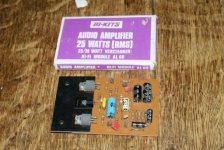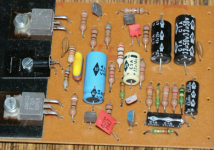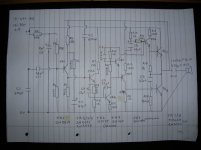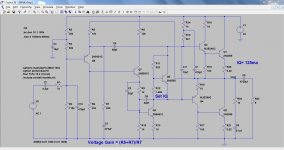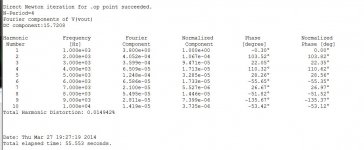Another older version link,
Found this..but no circuit...🙁
http://www.vintage-radio.net/forum/attachment.php?attachmentid=86747&d=1386549391
Bi-Pak audio modules - UK Vintage Radio Repair and Restoration Discussion Forum
Regards
M. Gregg
Found this..but no circuit...🙁
http://www.vintage-radio.net/forum/attachment.php?attachmentid=86747&d=1386549391
Bi-Pak audio modules - UK Vintage Radio Repair and Restoration Discussion Forum
Regards
M. Gregg
Should take you about 10 minutes to look at the board and draw the schematic from it.
Your right of course..😀
A few more pics found..🙂
I know the output transistors can be TIP41A<< I built this board as a big stereo one piece (DIY) years ago with a PSU, but I lost all the info..but the smaller ones..and the one in the middle of the heat sink..Good fun at the time..😀
The photo when expanded is about the same size as the original PCB..They don't exist anymore..
Regards
M. Gregg
Attachments
Last edited:
The nice thing about these modules was it only needed a simple PSU.
Simple Transformer rec and cap would run them..😀
Bolt them to a heat sink and that was it. Even the chassis would do it..😀
I used the 470uF with 8 Ohm speakers at the time..
Regards
M. Gregg
Simple Transformer rec and cap would run them..😀
Bolt them to a heat sink and that was it. Even the chassis would do it..😀
I used the 470uF with 8 Ohm speakers at the time..
Regards
M. Gregg
Last edited:
AL60 possible fun from the 70's
After a lot of help,
The original drivers were Tr5 BFS98 and Tr6 BFS61
Tr3 was BC171A<<in the middle of the heat sink.
In the past I used TIP41A output transistors.
Here is the result.🙂 Board traced out..what a PITA..😀
Transistors on the drawing are suggested types.
Regards
M. Gregg
After a lot of help,
The original drivers were Tr5 BFS98 and Tr6 BFS61
Tr3 was BC171A<<in the middle of the heat sink.
In the past I used TIP41A output transistors.
Here is the result.🙂 Board traced out..what a PITA..😀
Transistors on the drawing are suggested types.
Regards
M. Gregg
Attachments
Last edited:
Just thought,
I would mention it has been modelled and the THD is very interesting..😀
Suggestions were to increase the output cap size to 3000uF or more.
Regards
M. Gregg
I would mention it has been modelled and the THD is very interesting..😀
Suggestions were to increase the output cap size to 3000uF or more.
Regards
M. Gregg
A mod to increase stability,
0.22 ohm resistors are fitted on the emitters of the output transistors.
Regards
M. Gregg
0.22 ohm resistors are fitted on the emitters of the output transistors.
Regards
M. Gregg
Hi,
FWIW many sealed boxes will get along fine
with low output coupling capacitor values.
Basta! is good for playing with series caps.
e.g. http://www.humblehomemadehifi.com/download/Humble Homemade Hifi_Black Box_copy.pdf uses
600uF, and that could be the output electrolytic of a single rail amplifier.
rgds, sreten.
FWIW many sealed boxes will get along fine
with low output coupling capacitor values.
Basta! is good for playing with series caps.
e.g. http://www.humblehomemadehifi.com/download/Humble Homemade Hifi_Black Box_copy.pdf uses
600uF, and that could be the output electrolytic of a single rail amplifier.
rgds, sreten.
Last edited:
Hi,
I'm very much a novice but I've just bought a couple of these modules (eBay). I wanted to try something different to the ubiquitous Chinese (and more recently Sri Lankan (STK4191)) kits. So, have I dropped a clanger (bo***ck) or will these build to a reasonable quality (not audiophile) amp.
Any help or suggestions appreciated, even if it's to chuck them, after all they only cost me about 17 quid plus P&P. 🙂
Cheers,
Graham
I'm very much a novice but I've just bought a couple of these modules (eBay). I wanted to try something different to the ubiquitous Chinese (and more recently Sri Lankan (STK4191)) kits. So, have I dropped a clanger (bo***ck) or will these build to a reasonable quality (not audiophile) amp.
Any help or suggestions appreciated, even if it's to chuck them, after all they only cost me about 17 quid plus P&P. 🙂
Cheers,
Graham
You might be pleasantly surprised by just how good these can be.
The old electrolytics should be replaced and also the suggestion of M Gregg to fit 0.22 ohm emitter resistors could be worthwhile because the bias stability looks like it could be marginal.
The old electrolytics should be replaced and also the suggestion of M Gregg to fit 0.22 ohm emitter resistors could be worthwhile because the bias stability looks like it could be marginal.
Hi Mooly,
Thanks for the reply. I had it in mind to replace the electrolytics, are there any other pitfalls to look out for?
I don't know why I bought these, maybe they reminded me of something from my Dad's Practical Wireless magazines.
Cheers,
Graham
Thanks for the reply. I had it in mind to replace the electrolytics, are there any other pitfalls to look out for?
I don't know why I bought these, maybe they reminded me of something from my Dad's Practical Wireless magazines.
Cheers,
Graham
I would say to just be careful with the bias setting. It suspect it will tend to increase sharply as the outputs warm, taking some time to reach thermal equilibrium.
I have got the original circuit for the AL60 and AL125. I used the AL60 for my mobile disco for many years as well as the AL125 really reliable. They were made by Autona or Bi Pak as far as I remember. I later replaced the bd 911 with tip3055 on the AL60.
Honestly I love the sound from them much better than today's class d and h stuff
Honestly I love the sound from them much better than today's class d and h stuff
I know this is an old thread but just had to tell someone..! Whilst rooting around in an old spares box looking for something else, I came across an old AL-30 module. These were the 10w version. On a whim, I hooked it up to the bench supply and a test speaker and CD player. I was pleasantly impressed! The sound is very 'direct' and punchy with none of the soft muddiness of a lot of the modern stuff.It was a great find. I guess I must have bought this one (one of a pair) back when I was about 16! I remember seeing the AL-60 and the AL-125 advertised. Way out of my price range and power concept back then! 🙂
Another older version link,
Found this..but no circuit...🙁
UK Vintage Radio Repair and Restoration Discussion Forum
Bi-Pak audio modules - UK Vintage Radio Repair and Restoration Discussion Forum
Regards
M. Gregg
links no longer work
I have the circuit for the AL80 if you would like me to post it. I don't think there is much difference between the AL60 and the AL80
- Home
- Amplifiers
- Solid State
- Bi-Pak AL60
